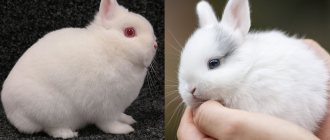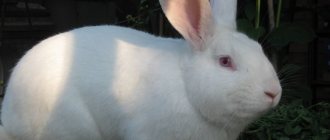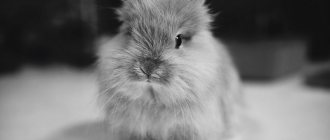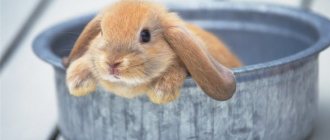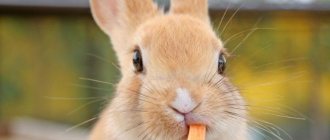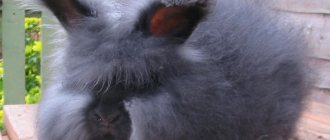How do rabbits behave?
Rabbits have many similarities in character and habits to cats. They also love to be petted and walk “on their own”: the little animal cannot be forced to do what it does not want. Fluffy pets do not like to be treated unceremoniously; they are offended if they are hurt or caused trouble. Like cats, they may not react to the presence of an offender for some time, bite or scratch, or even shit in an inappropriate place in retaliation.
The animals respond to the nickname, understand the intonation of the voice, gestures, and choose one owner for themselves - the family member who most often cares for the pet, pays attention to it, and pampers it. Domestic rabbits love communication and get bored if they don’t see people for a long time. A sign of trust in a person is permission to pat yourself on the stomach. When the animal feels good, it makes sounds - the rabbit cannot purr, but clicks its teeth.
It is easy to accustom pets to a cage, which they mistake for a house and enjoy spending time there. They relieve themselves in one corner of the cage - these are clean creatures. Maintain hygiene using the tongue.
Keeping a rabbit in an apartment causes some inconvenience. The big minus in his habits is that he chews everything that gets in his way: slippers, wallpaper, wires, furniture upholstery. A rabbit in an apartment, as in nature, is nocturnal - it runs around, stamping its paws, when its owners sleep. With age they become calmer. During puberty, their character changes, they become noisy, hooligan, mark their territory, and demand attention.
Animal protection
When purchasing a rabbit, you also need to consider its protection. The animal is partial to everything that can be chewed. He will definitely appreciate your new sofa, carpet, bedspread or electrical wires. When the animal walks around the apartment, all these dangerous elements must be hidden so that the rabbit does not have access to them. Tree branches or special toys will help solve the problem. Young rabbits require special attention; their need and desire to chew on everything is much stronger than that of an adult animal.
Gallery: decorative rabbits (25 photos)
What kind of cell should it be?
Before purchasing a pet, you need to buy a cage and think about where it will be located in the house. You can also make it yourself. There are several requirements for the home of a decorative rabbit.
The first thing you should pay attention to when purchasing is the dimensions. The size of the rabbit's home should be spacious, sufficient for the animal to rise on its hind legs and stretch out on the floor to its full height. The best option is when the rabbit can move around the cage. In this case, its size should be 4–5 times larger than the animal itself.
Recommended minimum dimensions: height - 60 cm, width - 60–70 cm, length - 1 m. When keeping several individuals, you should adhere to the norm of 0.15–0.20 sq. m. m for 1 rabbit. For dwarf individuals, a dwelling 70–90 cm long, 55 cm wide, and 45 cm high will be sufficient.
If you take a small house, then you need to think about the option of a fence for walking. An animal that is unable to move often gets sick.
A very good option is a cage with a walk. The standard dimensions of such complexes are: length - 2-4 m, width - 1 m, height - 0.4-0.5 m.
The second nuance that the buyer of the cage should take into account is the strength and environmental friendliness of the materials from which the house is made. Most often, wooden cages with a mesh facade are purchased for rabbits. Since decorative fluffies love to taste everything, the tree should be unpainted. Plastic structures are undesirable.
Important! You should avoid purchasing a wooden cage made from coniferous trees. It can emit a pungent odor that will scare away your pet.
Feeders and drinking bowls should also be safe. The cage must be equipped with at least three feeders designed for different types of food:
- hay;
- grain, juicy, green, concentrated feed;
- mineral supplements.
The water in the drinking bowl should be fresh every day. It is best to buy an automatic device. To keep your pet warm and comfortable, bedding must be placed on the floor of the cage. This can be straw with a layer of 10–20 cm or a special substrate purchased at a pet store.
There are times in the life of rabbits when they want to retire and isolate themselves from the noise and bustle. For such purposes, it is necessary to provide a special wooden rest house.
If you come across a smart baby, you can train him to use the tray. In this case, you will need to purchase a special container where your pet will go to the toilet. You need to put layers of paper, paper towels, sawdust, and shavings in it. Cat litter is also suitable, but it must be protected so that the animal cannot taste it, for example, covered with a mesh.
Decorative breeds
There are more than 200 breeds of decorative rabbits. They live 5-7 years, but with careful care their life is extended to 10 years.
How to care for rabbits depends on the characteristics of the breed. The following animals are most often bred:
- Colored dwarfs, or dwarf shorthairs. They got their name because of the variety of colors (more than 60 species), but white is considered the most beautiful. Until they are one and a half years old, they scratch and bite. To reduce aggression, castration is performed.
- Lion breeds (Lions). They are called so because a mane grows around the neck and head, like a lion. And even with their muzzle, some look like the king of beasts. This type is called Lion's Head. These are small animals, weighing no more than 1.2 kg. There are rabbits with long hair - the Angora lion. The fur hangs over the eyes and covers the ears. It needs to be trimmed regularly. Lions have such a calm character that it is safe for children to play with them.
- Dutch rabbits. They have an interesting color, shiny, soft wool. They weigh no more than 1 kg, but there is a separate species that grows up to 2-2.5 kg. The animals are obedient, smart and sociable, get along well with children, but are energetic and require increased attention. Easy to care for.
- Angora rabbits are fluffballs of two types. One has fur with a hair length of up to 20 cm, which feels like cotton wool to the touch. Your fur coat requires daily care. Another species has shiny fur that does not exceed 5 cm in length, which makes it easier to care for.
- Dwarf rexes. They grow up to 1.4 kg in weight. They have royal status. They are called plush for the quality of their wool. A fur coat of amazing beauty and a wide range of colors requires careful care. Smart, obedient, safe for children, easy to train. This makes caring for rabbits easy and enjoyable.
- Fold sheep are cute, harmless animals with a good character. They have a head similar to a lamb, long hanging ears (22-27 cm), due to which they have difficulty hearing. Thanks to this, they are extremely calm and fearless, which is why keeping decorative rabbits of this breed is recommended for families with small children. Caring for them is easy.
What should a rabbitry be like?
A place for breeding rabbits in a country house or plot is a rabbitry, most often a wooden structure in the form of an old cabinet, which consists of individual wooden cages or the structure itself is divided into smaller cages.
Playpens are usually constructed of mesh and the animals are divided into groups.
Arrangement of the cage
The cells must be:
- dry,
- clean,
- light,
- sealed.
Outdoor cages should be covered - rabbits do not like rain, harsh light, and should not be kept in the sun.
To ensure effective urine flow, a double floor is made. The lower floor should be sealed and slightly sloping, the upper floor should be secured with slats spaced 1.5 cm apart. In winter, a large amount of bedding should be provided.
Rabbits require cages of the appropriate size. When choosing cells, you need to take into account the specialization of selection (skins/meat) and the breed of animals.
The figure shows the dimensions for keeping 1 rabbit. When keeping in groups, the cage size should be increased in proportion to the number of animals kept. It is optimal to keep 2-3 animals in a cage, which allows you to strengthen control in the herd, easily monitor diseases, and respond to aggressive behavior.
When raising rabbits for meat, it is better to keep them in large cages to ensure a lot of movement, which has a positive effect on the quality of the meat. It is important to group animals by breed, age, and gender. This prevents rabbit cannibalism and biting.
A large number of animals in a cage increases the number of pathologies by 15%, leading to excessive obesity of animals.
Adult males should be kept in separate cages or boxes. Each of them should have his own cage where he will feel safe. The male's cage should be located away from the females, the smell of which can stimulate the male to constant activity; he will waste energy unproductively, trying to get out of the cage. It is best to place the males' cages in a separate room or outdoors, away from the rest of the nursery. If this is difficult to do, cages should be placed to the side of a large group of cages or on the top floor.
The separation of animals is also aimed at limiting the spread of pathogens and the possibility of using a different feeding system.
Manure should be removed, cages cleaned, disinfected weekly, then re-lined with fresh straw. This will keep the animals healthy. Rabbit manure can be used as fertilizer.
Temperature, lighting, humidity
Animals need to be provided with:
- access to light
- optimal temperature,
- required humidity.
It is important to provide animals with good air access. If you are serious about rabbits, you will need summer and winter cages (located indoors).
Rabbits need access to natural or artificial light. Light is an important factor affecting the reproduction of rabbits. The cages need to be equipped with feeders, drinking bowls, and houses for females.
In winter, it is necessary to provide a large amount of bedding and access to light: 14-16 hours a day.
Optimal room temperature:
- for females with cubs – 18 g. C, as the animals grow, the temperature can be reduced;
- adult individuals can be kept at a temperature of 12-14 degrees C.
Humidity should be about 65%; too low humidity can cause dry mucous membranes, reducing the resistance of animals to diseases of the respiratory system.
Ventilation
Gravity ventilation and room ventilation are usually used. Ventilation serves to remove moisture and harmful gases that threaten the health of animals. It is important not to create drafts and that the cages do not stand in a direct line to the fresh air intake.
Keeping rabbits
How to keep a rabbit? This is the daily work and attention that a furry pet requires. Sometimes maintaining them involves unpleasant troubles. Keeping decorative rabbits at home can be done by someone who is not afraid of worries, is ready to forgive pets for their pranks and put up with certain inconveniences. To care for and maintain decorative rabbits you need the following equipment:
- A large, comfortable cage with a solid floor, because the structure of the legs does not allow free movement on the grid. Cover the corner of the cage or place a box for the pet to hide there.
- Aviary, if walks around the apartment are not provided.
- A drinking bowl or feeder is preferably heavy, for example ceramic, so that the eater who likes to scatter food does not turn it over with his teeth. A plastic feeder is attached to the cage. Container for storing hay.
- A tray with litter, a scoop and vinegar to neutralize urine odor.
- A thick branch for a rabbit to sharpen its teeth.
- Scissors - cut nails, combs and grooming brushes.
- Toys to chew on instead of furniture.
Your furry friend's cage should not be placed near a window, close to a heating radiator, or in a draft. The animal is kept at average room temperature, because the animal cannot tolerate heat or high humidity. For this reason, rabbits do not need water treatments: they independently maintain the cleanliness of their fur coat.
Caring for rabbits at home does not require special knowledge, although the animals are gentle, have weak immunity and are susceptible to diseases.
Caring for rabbits at home does not require special knowledge
Nutrition
Proper nutrition for a decorative rabbit should include all the necessary substances and minerals. A responsible approach to animal nutrition will extend its life, provide good health and strong immunity.
The main diet of a decorative rabbit:
- Special food;
- Purified drinking water;
- Hay (necessary to maintain chewing function and proper bowel function);
- A small amount of fresh fruits and vegetables;
- Tree branches (rabbits love to chew on things);
- Oat and barley grains.
Important! Rabbit digestion is particularly sensitive. A rabbit should not be fed anything, especially human food. Some plants are also prohibited, such as celandine, hemlock, larkspur, veh, buckthorn, and buttercup. It is better not to include belladonna, blueberries, spurge, or geranium in the diet of a young rabbit. Coarse plants such as rushes or reeds or large hay are prohibited. If you want to give your animal nettle leaves, they must be dry.
Useful herbs: meadow clover, alfalfa, vetch, wheatgrass, oats, dandelions, plantain, burdock and yarrow leaves.
Rabbits need to chew something, so they wear down their teeth. Branch food will be a good supplement. You need to be careful with spruce, oak, birch, pine and alder branches. They contain components that, if abused, can cause illness.
Furry pet care
Those who want to have a furry pet are primarily interested in how to properly care for rabbits so that the animals grow healthy, reproduce, and do not create problems and discomfort for their owners. Looking after rabbits at home is as follows:
- Feeding. The diet must contain the necessary components. You should not overfeed - this causes obesity, which has a bad effect on health and reproductive abilities.
- Cleaning the cells. The presence of an unpleasant odor in the house depends on how to care for domestic rabbits. The feeder and tray are washed daily. The cage itself is cleaned once a week. Cleaning and disinfection are carried out every month.
- Caring for decorative rabbits involves combing the fur and cutting it. This is done regularly so that the fur does not settle on the floor, furniture and does not accumulate in the stomach of the little tidy. Rabbits are bathed only in exceptional cases.
- Trimming nails is a mandatory procedure, because they grow, and the rabbit grinds them down on furniture, walls, and scratches painfully. Shorten the claws carefully so as not to damage the blood vessels.
- Vaccination. Animals are susceptible to the same diseases as ordinary rabbits. The most dangerous diseases are myxomatosis (spread by mosquitoes) and viral hemorrhoidal disease. They give a mortality rate of 70-100%. The first vaccination is carried out at the age of 28-45 days, and then once a year. If necessary, vaccinations are given against pasteurellosis, paratyphoid fever, rabies, etc.
- Deworming. Held every quarter.
When should you contact a veterinarian?
Warning signs: excessive nasal discharge, sneezing, tears, runny nose, swollen eyelids, pus, grinding of teeth, poor or no appetite, distended abdomen, lack of bowel movements or liquid feces, formations and tumors on the body, bald spots on the coat and copious amounts of it. hair loss, dirty fur, wet face, rapid breathing and heart palpitations.
Each of these symptoms may be the result of an animal illness. Once any of these signs are detected, the rabbit must be taken to a veterinary clinic immediately, because the disease spreads quickly and death can occur quickly.
Buying a rabbit
Breeding decorative rabbits brings not only the pleasure of interacting with interesting animals, but also good money. Animals begin to reproduce at 6-7 months. The female brings 4-6 rabbits every 3 months, and at the age of 1-3 months they are already sold. They cost more than regular breeds.
To buy a healthy animal, it is better to contact a breeder or a rabbit nursery, where they will tell you how to care for a decorative rabbit. When purchasing, the following is taken into account:
- Age. Up to 1 month, the baby rabbit feeds on its mother’s milk, and the older the baby rabbits, the more difficult it is for them to get used to their new owners and show aggression. In a three-month-old rabbit, the characteristics of the breed are already clearly expressed, and the sex is determined.
- Clean butt: so that there are no signs of diarrhea or discharge from the genitals.
- Clean nose, eyes, ears.
- The appearance of the fur is clean, smooth, shiny.
- Animal behavior. If he sits with a ruffled look, it means that not everything is all right with him.
- Correct bite. If the bite is incorrect, the teeth will not grind down, and this will place an additional burden on the owner: they will have to be trimmed constantly.
If the animal walks in your arms, is not afraid and does not show aggression, you can safely buy it - this is your rabbit.
Pregnancy, birth and first month of life of baby rabbits
The breeding process of rabbits does not depend on the time of year. A female is capable of giving birth more than 20 times a year. It is this high birth rate that has allowed rabbits to survive in the wild, where they can be eaten by many predators.
Sexual maturity of a farm rabbit occurs at the 6th month, and for a dwarf rabbit at the 3-4th month. Young rabbits are extremely fertile: in captivity, 1 female rabbit can give birth to up to 12 rabbits.
If you have determined that a female is pregnant, you must be prepared to provide her with proper care. The duration of pregnancy lasts about a month and depends on the number of cubs. The more babies in one litter, the faster they are born. For good fetal development, you should review the diet and make it more saturated. On the farm, expectant mothers need to make a separate enclosure where nests are installed. During pregnancy, a female rabbit can be aggressive and start fights. The female should be protected from contact with other pets and kept alone. The queen cell will help you take your mind off stress: female rabbits love to arrange their future nest by tearing out the fluff from their belly and insulating it with hay.
Rabbits are born blind and helpless early in the morning or in the middle of the night. You should not touch the female during childbirth unless absolutely necessary: the animal is extremely vulnerable. The young mother feeds and licks the cubs twice a day. If the female refuses the rabbits, then they need to be placed with another nurse. To do this, you should put the unscrupulous female in another cage, wipe your hands with wormwood and place the refuseniks in another rabbit. This must be done extremely quickly, otherwise the little rabbits may die.
The domestic rabbit grows quite quickly, and after 2 months the rabbits are ready for independent living.
A place in the house for a fluffy
Eared pets should be provided with the following important conditions:
- sufficient light;
- warm;
- dryness;
- good ventilation;
- no drafts.
To provide these conditions, it is necessary to choose the right location for the rabbit house. It should be placed in a bright place, but away from direct sunlight - at high temperatures, rabbits can experience heat strokes. Daylight hours should last approximately 17 hours.
The corner where the cage will stand should be warm, but not hot.
There should be no heating devices or radiators nearby. A comfortable temperature for rabbits is considered to be 12–18 degrees. They can withstand short-term drops in the thermometer down to -6 °C and increases up to +35 °C. In order for there to be good air exchange in the place where the rabbit lives, short-term ventilation is necessary in winter, and a slight draft is allowed in summer.
Harmful products
Some products are of little benefit and are even toxic to decorative rabbits. These include:
- store-bought food for birds and rodents;
- corn, dried peas, beans;
- boiled vegetables, greens;
- sweets, baked goods;
- bread, porridge, muesli;
- nuts;
- onion;
- sorrel;
- lemon;
- avocado;
- sweet fruits.
It is important to keep the cage and equipment clean, and clean the tray regularly. You should change the water daily, add fresh food, and monitor the amount of hay consumed. Long-haired breeds of decorative rabbits require daily brushing. Bathing is extremely stressful for rabbits, so water procedures are carried out in case of emergency.
When getting rabbits, you need to understand the full responsibility for the health and life of the pet. Decorative rabbits are sensitive and require careful handling; they need to be cared for with love. Nutrition plays a big role in the quality of life. A properly formulated diet and proper feeding are the key to successful and long-term maintenance.
